Italy 1943-45
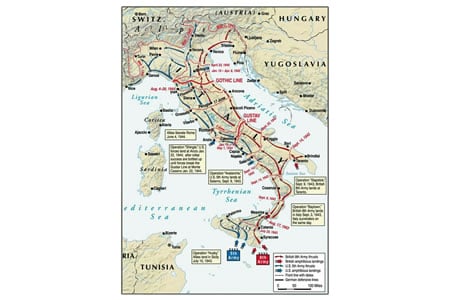
The 3rd, 4th and 7th Hussars all took part at various stages in the Italian campaign.
at Citta Di Castello
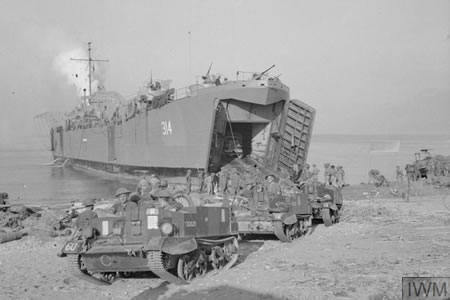
The Push along the Tiber Valley – Jun-Jul 1944
The 3rd Hussars – It was not until the 30th of April of 1944 that the 3rd Hussars landed at Taranto and within two weeks were put back into action pushing the Germans out of Italy.
In June and July the 3rd Hussars led the advance of the 78th Division up Italy reaching Citta Del Piave and fighting then at Ripa, Montone, Citta del Castello and Pistrino in the Tiber valley.
The 3rd Hussars fought against elite German paratroopers from Orvieto to Citta del Piave in Italy in 1944. In the latter they were ordered to attack with only one Squadron against an enemy that had been reinforced overnight.
The 3rd Hussars had led 130 miles of successful pursuit when an order came that all personnel who had served overseas for four and a half years were to be sent to England.
This was disappointing as they had always suffered the brunt of the battles but rarely enjoyed the easier work of the pursuits.
The 3rd Hussars then moved to Syria where they were for the capitulation of the Axis powers on the 6th of May 1945.
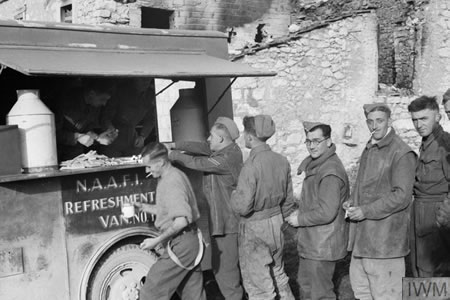
Arrival in Italy – 4 May 1944
The 4th Hussars – On the 4th of May 1944 the first personnel disembarked at TARANTO and with that the 4th Hussars had rejoined the fray in Italy as the Armoured Reconnaissance of the 1st Armoured Division equipped with both heavy and light tanks.
By the start of June a period of training had started with the intention of them becoming fully operational in the near future.
The 7th Hussars – On the 4th of May 1944 the 7th Armoured Brigade began disembarking at TARANTO. It moved up at once by rail and road to the Lanciano area, where concentration was completed by the 9th.
All through May the 7th Hussars remained in the Lanciano area and the 5th Corps made no forward move. On the 15th of June the 7th Hussars were removed from the 7th Armoured Brigade and placed under the command of the 2nd Polish Corps.
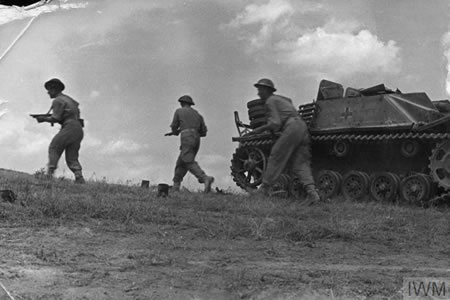
Ancona – 2-18 Jul 1944
The 7th Hussars – The 2nd Polish Corps, along with the 7th Hussars, were engaged in chasing the retreating Germans in the Adriatic sector.
The 2nd Polish Corps objective was the capture of Ancona harbor. The orders given by the commander 2nd Polish Corps to his units were simple, direct, and aggressive. ‘Pursue the enemy at the highest possible speed and capture Ancona harbor.’
General Anders, commanding the 2nd Polish Corps, also deceived the Germans. He created the impression that the 3rd Carpathian Division would attack along the coast road. Instead, he launched the 5th Kresowa and the 7th Hussars on an encircling sweep inland. Anders performed a series of feints, radio deception, and skilled maneuver, unhinging the German 278th Division, which resulted in the capture of the city on the 18th of July. The taking of the port of Ancona significantly shortened the allied lines of communication.
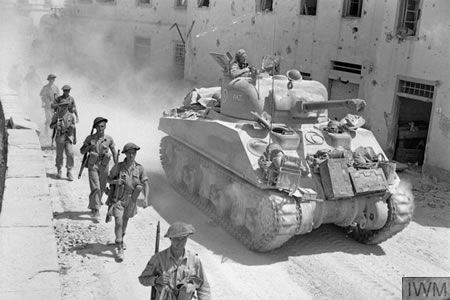
Gothic Line broken through – 2 Sep 1944
Allied attacks concentrated on the eastern end of the line, where the natural defences of the Apennines gave way to hilly terrain crossed by a series of rivers. On 25 August 1944, the 8th Army advanced; by 2 September the eastern end of the Gothic Line was breached. The 5th Army attacked the west of the line on 13 September, pushing through the Apennines and reaching the outskirts of Bologna on 23 October.
The 4th Hussars – During the month of September the 4th Hussars were in continuous battle from the 3rd to the 25th, the period immediately preceding first contact on the 4th of September being occupied by long forced marches by day and night. The great majority of Officers and men therefore had no sleep for over 60 hours before entering the battle. In spite of this and the difficulty of carrying out normal maintenance, the condition of the tanks remained excellent and the health and moral of all ranks was maintained at a high level.
The contention previously expressed that the removal of the turrets from Stuart recce tanks was a mistaken policy was amply and sadly proved by the experience of battle. Not less than 80% of the total casualties of the 4th Hussars were sustained by personnel of these tanks owing to heavy enemy shell and mortar fire.
An example of this was given on the 5th of September when the Recce Tp of 12 turretless tanks was given a special mission of recce of CORIANO, reported not to be held by the enemy.
The required information was obtained but the strength of Recce Tp in personnel and tanks was reduced by 50% during this operation through enemy artillery concentration.
The 7th Hussars – On the 11th of August, the Cesano River was crossed, and the 2nd Polish Corps seized a series of towns, Gabrielle, Mondolfo, Poggio, and Orciano. Ten days later, the 7th Hussars along with the 2nd Polish Corps, crossed the Metauro River and reached the Gothic Line.
The Allies now reorganised their forces before the assault on the Gothic Line. The 2nd Polish Corps was on the extreme right flank at the Adriatic coast with the 1st Canadian Corps on its left. Operation OLIVE, the breakthrough in the Adriatic sector, began on the night of the 25th of August. The 2nd Polish Corps opened the offensive, capturing the high ground north of the resort of Pesaro.
The 7th Hussars were fighting with the 2nd Polish Corps and were leading the armoured spearhead thrusts against the Gothic Line throughout September.
The night attack by the 2nd Polish Corps, 1st Canadian Corps, and the 5th British Corps caught the Germans flat footed and pierced the eastern flank of the Gothic Line.
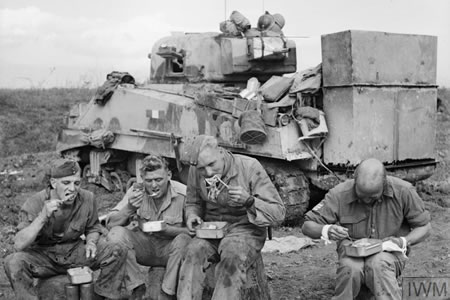
Senio Pocket, 4-5 January 1945
The 4th Hussars – From 2 January ‘A’ and ‘B’ Squadrons, 4th Hussars, fiercely resisted strong German attacks on the Allied line between Conventello and Lake Comacchio, successfully holding the line.
The 4th of January 1945 saw the first proper use of the Kangeroos by ‘C’ Squadron, 4th Hussars, and the 2/6th Battalion, The Queen’s Royal Regiment, in the deliberate assault in clearing a bulge from the east bank of the Senio River was an outstanding success.
Meanwhile, two days earlier ‘A’ Squadron, 4th Hussars, had distinguished themselves in repulsing an attack by German infantry.
There was another lull in the conflict, mainly due to the weather conditions, until April 1945 before the final battles up to the River Po and at the Argenta Gap.
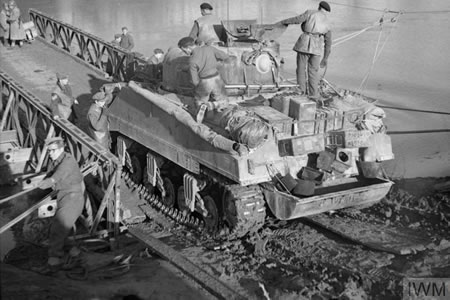
The Crossing of the Senio River – April 1945
The 4th Hussars – In early April 1945, the 8th Army was holding its winter line on the Senio River from Lake Commacchio in the north to Brisighella in the south.
After crossing the Senio River, ‘C’ Squadron, 4th Hussars, along with the 2nd New Zealand Division continued to the Santerno River and then on to the Gaiana River.
After a brief halt they then pushed on to the Idice, finally crossing the Po River.
Meanwhile ‘A’ and ‘B’ Squadrons of the 4th Hussars, along with the 78th Division, played a vital role in the battle of the Argenta Gap.
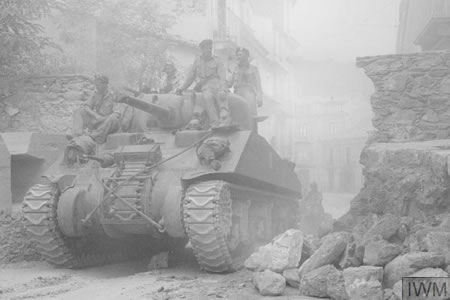
Final Push to Venice and Trieste – 9 Apr 1945
The 7th Hussars – The final offensive to break the stalemate on the Italian front was scheduled for the night of the 9th of April 1945. The Eighth Army objective was to break through the Po Valley and seize the cities of Bologna and Florence. The 2nd Polish Corps was assigned the direct assault across the Senio River straight to Bologna.
The 7th Hussars, supported the crossing of the Po, on a wide frontage, playing a leading part on the whole front of the 8th Army. Lt-Col Congreve and his RHQ directed the technical side of the river crossing on one sector of the front. ‘A’ Squadron, was placed under command of 56th (London) Division, ‘B’ Squadron went to 8th Indian Division and ‘C’ Squadron to 6th Armoured Division, with a troop of ‘C’ Squadron also being detached to 2nd New Zealand Division. The Squadrons did not meet again until the pursuit was over. Within a week the 7th Hussars were spread around the head of the Adriatic with its extremities 150 miles apart.
‘A’ Squadron, 7th Hussars, (by now re-equipped with Sherman DD tanks) crossed the Po on the evening of 25th April, with no casualties. On the 27th April 1945 at 11 pm at Pioppe, five DD Shermans swam the River Adige, followed by 2/7th Queens in Fantails and the hot pursuit continued, which meant that by 9 pm on 28th April the 2/7th Queens and 7th Hussars column was held up near the canal bridge at Brenta only three miles from the great Venice lagoon.
The next day at the canal bridge at Dolo the column met the New Zealanders arriving from Padua. Then a 30 minute argument ensued, about who should lead into Venice? The New Zealanders had maps of the area and also had wireless contact with Divisional, and higher, formations, so claimed the privilege. Both columns set off and at Mestre the New Zealanders kept straight ahead, while the 2/7th Queens and 7th Hussars turned off down the causeway into Venice.
The port authorities surrendered and ‘A’ Squadron moved into leaguer in the docks area. An hour later ‘B’ Squadron arrived having supported the Royal Fusiliers and 5th Gurkhas across the same three rivers starting from near Ferrara to Canale Bianco and Roverdicre.
Another seventeen DD Shermans loaded up a company of 5/5 Mahratta Light Infantry (8th Indian Division) and set off along Route 16 to Battaglia, sped through Padua along the autostrada into Venice, there they harboured in the Piazzale Roma instead of the docks. ‘C’ Squadron were held back after the Po and Adige crossing, as the New Zealanders had road priority. However, 4th Troop of ‘C’ Squadron allied to 20th New Zealand Armoured Regiment drove via Padua, Musile and Route 14 straight for Trieste, where having covered 97 miles in one day, they entered the city and met a patrol of the Long Range Desert Group there.
Of the fifty-seven 7th Hussar DD tanks that had set off and eighteen were still fit for swimming at the end (Venice lagoon or Trieste). All of the rest except one were recoverable.
By the time the capitulation was signed 7th Hussars were concentrated at Mestre.

